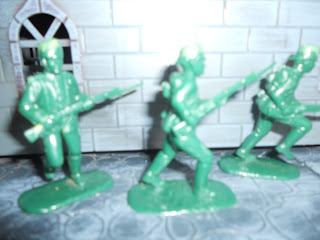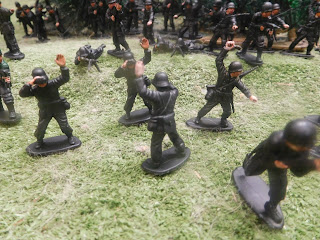Flocking.
There is no one way to flock. For many of you this will be like telling grandma how to suck eggs. Do grandmas really do that? I know mine made a lot of egg flips but that was about it. Anyhow, I'll shepherd you in some tips about flocking. Shepherds, flocks? Get it? I can't help myself sometimes.
So, you can use sticky paint covered in flock; green gloss enamel works best as it take longer to dry and generally has more holding power than acrylic. I prefer to do some preliminaries first. Usually I coat bases in PVA and add a mix of sand, kitty litter, gravel, tea and coffee. When it is dry I paint it a sand color and then add a brown wash. if it is going to represent desert I also dry brush with light sand. When that is dry I add patches of more PVA and then the flock which is a mix of three or five different flocks. The amount of PVA and green flock is less according to how dry the land is meant to be. You can also mix a little sand with the flock. I assess that PVA has better holding properties than paint. Another option is to paint bases green and then, paint on PVA and sprinkle or submerge in flock. This is good for especially 'well watered' terrain.
Yet another option is to use the PVA and add fine sawdust (easy to get from any place which cuts wood). When dry paint green and later dry brush with lighter shades with the last dry brush made from yellow paint with a little green added. I have also glued on shortly cut doll, human or cat hair and and given it the same treatment. Also, blonde hair looks good unpainted as dry grass.
Below are pictures of flocked Later Confederacy/Spanish Civil Guard figures. Parts of the earth base are allowed to show through the flock. The glue is not yet dry and can be discerned.
Sprays and flock: Sprays and flock don't go well together. The options are to do all your spray varnishes or fixatives BEFORE applying flock later when figures are dry OR make very sure there is no loose flock before spraying. If you don't you will end up with little bits of flock (especially the static grass version) stuck over your figures. I guess you could say it is just like real life where soldiers get bits of terrain stuck on clothing and boots but it really looks bad and unnatural with even faces sporting grass moustaches. So you really have to tap the figures and tap again. Empty them out of the tray or box, get rid of any flock that comes off and after tapping figures and blowing off any remaining flock place them into your spraying tray - I often use cardboard cat food trays. Another technique, I have not tried is using a vacuum cleaner (carefully!) to suck off remaining loose flock. You could make a smaller nozzle for the Vacuum cleaner using card with a central hole and a glued empty biro in the center. (I got that idea from an old issue of Airfix magazine).
So why go for the second option of spraying after flocking? I still do it because it adds to fixing the flock permanently to the bases.
Of course there is another option. Many do prefer to leave bases without flocking. The advantages of flocking is it helps hide the transition between the integral figure base and the new added card (or other material) base. At a distance he flock also looks like real terrain.












I use MFD of 4 mm thick, covered with woodfillel and sand mix. I let this dry, paint it and then I use PVA glue and static grass. Also little rocks and flowers or other things can be added. Examples can be found on my blog!
ReplyDeleteGreetings
Peter
https://peterscave.blogspot.com/